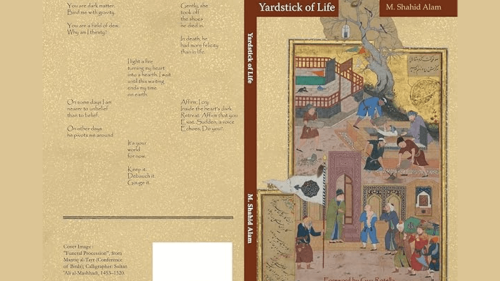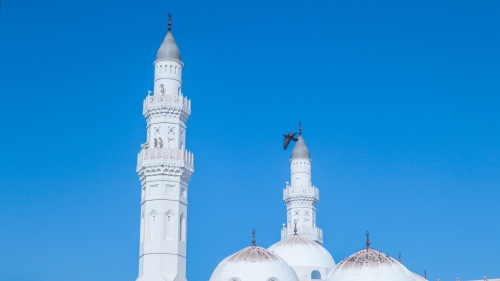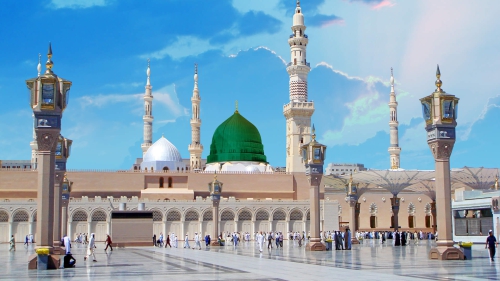Islamic or Muslim Architecture

Many people wonder what authentic Islamic architecture and its scope are, and whether it is appropriate to qualify such a wonder as Islamic, Muslim or something else, architecture. Much has been written and said about the subject, yet scholars and researchers vastly differ over it. It is an endless, but at the same time enthralling, debate.
Islamic architecture is an architecture that exemplifies Islamic teachings and values in an architectural process rather than in an architectural product. An architectural process starts with having a proper understanding and vision which leads to making a right intention. It continues with the planning, designing and building stages, and ends with attaining the net results and how people make use of and benefit from them. Islamic architecture is a fine blend of all these phases and elements which are interwoven with the threads of the belief system, tenets, teachings and values of Islam. What makes an architecture Islamic is its metaphysical, spiritual and ethical dimensions, rather than its sheer physical and observable aspects, in relation to all the parties involved in the process: patrons, architects, engineers and ordinary users, and the implications of their diverse conceptual and practical relationships with architecture.
This however does not mean that the physical side of Islamic architecture is unimportant. On the contrary, it is important, but remains subservient to the metaphysical, spiritual and ethical factors. Reducing the orb of architecture to its sheer artistic, technological or engineering aspects, and singling out architects and structural engineers as the sole protagonists in it, significantly downgrades architecture and divests it of some of its most dynamic dimensions. By saying this, no diminishing or taking away any credit whatsoever from anyone who duly deserves it, especially architects, is intended. Islamic architecture, it goes without saying, must not be seen as an elitist enterprise. It is a scientific as well as an epistemological pursuit that aims to ensure the welfare of all Muslims. Islamic architecture should be practical in the sense that it is affordable, accessible, functional and should tackle the issues and problems concerning all Muslims. It further must not be discriminatory, impractical and utopian.
If one studies the corporeal side of Islamic architecture only, one is bound to end up asserting that it has little if any religious content, and that the Qur'an and Sunnah, which are the original sources of Islamic revealed knowledge, do not contain any doctrine of the arts. Their role is limited to a very few features, such as the ban on the representation of human beings, the Prophet's houses, his pulpit (minbar) and the requirements related to the form of the ritual prayer in the organization of the mosque. Islamic architecture would thus simply be "a complex synthesis of different legacies, and cultural and political statements as well". Calling such a one-dimensional architectural legacy Islamic, in the sense that it embodies and echoes Islam as a worldview, Shari'ah (law) and a way of life, would be grossly inappropriate. Therefore, it has been often suggested that the use of the term Islamic to qualify the architecture of the Islamic world after the rise of Islam should be suspended "until more conclusive research is conducted".
This nevertheless represents a set of fairly sensible contentions, provided the same is observed against the backdrop of its fundamental epistemological premises that inexorably lead to making such judgments. However, architecture is more than pure art, science and technology, just as Islam is much more than mere slogans, symbols, forms and plain rituals. Thus, if seen as a physical locus of the lifestyles that are inspired, guided and even dictated by the total message of Islam, which is meant not only to facilitate and promulgate such lifestyles, but also to integrate itself into and become an integral part thereof, Islamic architecture suddenly becomes a different and much more complex and profound proposition. As a process and total framework meant for the facilitation and implementation of Islam, Islamic architecture, in fact, becomes both a quintessence and unmistaken manifestation of Islamic ways of life. It thus merits being qualified Islamic.
Isma'il al-Faruqi thus wrote on the relevance of Islam to architecture: "Throughout the Muslim world, architectural unity is a facet of unity of the ummah under Islam ... The characteristics which constitute the unity of architectural styles throughout the Muslim world are provided or inspired by Islam ... It will be a terrible shortcoming if Islam neglected to influence the architecture of its peoples. Like all other fine arts, architecture is an aesthetic expression of the Muslim in so far as he has a unique and distinct view of reality, of space and time, of history, of the ummah and of his organic relation thereto. Islam is indeed a comprehensive religion, worldview and culture. Its influence must pervade the whole of human life. It did determine the style of clothing, of eating, of sleeping, of socializing, of leisure and recreation. How could it omit to determine man's habitat? Nay, it did; and it even buttressed its influence with the power of law as regards all these."
Titus Burckhardt in the same vein said that "it is not surprising, nor strange, that the most outward manifestation of a religion or civilization like Islam - and art is by definition an exteriorization - should reflect in its own fashion what is most inward in that civilization." He also said that studying Islamic art and architecture sincerely and with a certain open-mindedness can lead "to a more or less profound understanding of the spiritual realities that lie at the root of a whole cosmic and human world". He summed up the matter when he said that if one were to reply to a question 'what is Islam?' by simply pointing to one of the masterpieces of Islamic art and architecture, that reply, summery as it is, would be nonetheless valid, for the art of Islam expresses what its name indicates, and it does so without ambiguity.
However, perceiving thus Islamic architecture is rather idealistic and signifies one's dwelling on the theoretical or philosophical plane alone, whereas the Islamic architectural reality is more than the plain theory. It is a combination of Muslims' comprehension of the latter, as part of their comprehension of the original sources of Islam and Islamic knowledge, and their application of the same in time and space. Some of the results of such a combination are often stained by a myriad of Muslims' shortcomings, in which case the adjective Islamic attached to the Muslim architectural realities may have some unbecoming implications. Consequently, it is often suggested that the term Muslim, rather than Islamic, be used when describing the architecture of Muslims in any given epoch or geographical region. It is at times even suggested that it would be much better if neither Islamic nor Muslim is used, for both, if misconstrued or taken out of context, can seriously mislead and puzzle.
At any rate, Islamic architecture is such a fascinating, broad, profound and multidimensional subject to study. It thus could be approached from numerous perspectives: artistic, technological, scientific, social, political, economic, cultural, spiritual and environmental. Study approaches could be both theoretical and empirical, and methodologies both qualitative and quantitative. However, whatever research study is undertaken: empirical or non-empirical, academic or applied, limited or total, Islamic architecture as a revolutionary phenomenon should always be viewed as one of universal and abiding significance that unmistakably reveals the heavenly standards and values that gave rise to it. True, it was as responsive to the climatic, geographical and cultural requirements as any other architectural tradition. Nevertheless, it never treated them away from the exigencies of a higher order and meaning of things. By means of skills, creativity and imagination, on the one hand, and by its distinctive combination of aesthetic and utilitarian ends, on the other, Islamic architecture never drew a wedge between the physical, psychological and spiritual needs of man who has been created as God's vicegerent or trustee on earth. As such, man's earthly mission is all about generating sustainable civilizations and cultures, whose framework or physical locus, in turn, is architecture.
It follows that articulating the term Islamic architecture would be correct, especially when dwelling theoretically on the theme and when architecture is understood as a comprehensive process and system implemented with relative success into actual life situations. The Muslim architecture designation, too, would be correct, especially when referring to the technical and empirical aspects of the subject and when certain Muslims' architectural legacies, often stained with their major spiritual, ethical or intellectual flaws, are targeted. Even giving no adjectives or appellations to the architectural styles created by Muslims would be correct, especially when it is recalled that early Muslims never called their architecture, art, urbanism, etc., Islamic or Muslim. They knew that those were their own legacies spontaneously generated and imbued by the impetus of their perceptions of reality and the world, of life and death, and of space and time, and which were part of their larger civilizational vision and drive. Giving designations under the circumstances was superfluous, as the things were instinctively implied and understood by everyone, and the culture of giving precedence to substance over the form largely prevailed.
However, when mere names, titles and descriptions became an obsession, such denoted a sign of civilizational weaknesses and decline. It meant desperate clinging to something that was gradually fading away and was hard to keep. The efforts in due course turned into sheer reminiscing about things that were lost and became difficult to bring back. Hence, reminiscing became nostalgia, and the latter soon morphed into individual and collective acts of desperation.
Finally, it was in fact non-Muslim scholars and researchers who especially during the colonization era coined and imposed on the world first those artificial appellations as regards Islamic civilizational legacies, including architecture. It was also them first who in the process loaded the terms with some erroneous, or questionable at best, connotations. So therefore, while it is possible to use any of the existing designations often attached to the historical and current architectural realities of Muslims, Muslims, at the same time, should be aware of the implications each and every designation entails, so that the most appropriate terms, those closest in describing an intended matter, are selected and articulated. Numerous fallacies and misconceptions, old and new, associated with different aspects of the architecture of Muslims, are also to be scientifically and thoroughly unraveled and repudiated.
But these ought to be no more than interim and short-term strategies. They are by no means to be regarded as ends in themselves, as they cannot offer permanent answers and solutions to the pressing dilemmas. Rather, those and other similar intellectual efforts and activities must represent - or at least be precursory to -- a gradual fashioning of a new and unified scholarly culture among Muslims that will be closest to reverberating the authentic philosophy of Islam and the soul of its teachings and values, paying no or very little attention to the often meaningless and worthless appellations, labels and descriptions. The new comprehensive intellectual culture will need to skillfully amalgamate the fundamental nature of the Islamic message with the spirit and exigencies of modern times, dispensing generally with religious, cultural and intellectual mediocrity, prejudices, formalism, literal symbolism and apathy, which can seriously damage the prospects of reviving not only Islamic architecture, but also all the other aspects of Islamic eclectic culture and civilization.
======
 |
Topics: Islamic Art And Architecture, Islamic Culture And Civilization
Views: 14455
Related Suggestions
















